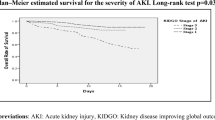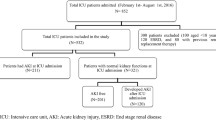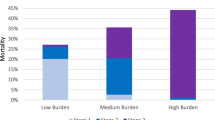Abstract
Purpose
Current reports on acute kidney injury (AKI) in the intensive care unit (ICU) show wide variation in occurrence rate and are limited by study biases such as use of incomplete AKI definition, selected cohorts, or retrospective design. Our aim was to prospectively investigate the occurrence and outcomes of AKI in ICU patients.
Methods
The Acute Kidney Injury–Epidemiologic Prospective Investigation (AKI-EPI) study was an international cross-sectional study performed in 97 centers on patients during the first week of ICU admission. We measured AKI by Kidney Disease: Improving Global Outcomes (KDIGO) criteria, and outcomes at hospital discharge.
Results
A total of 1032 ICU patients out of 1802 [57.3 %; 95 % confidence interval (CI) 55.0–59.6] had AKI. Increasing AKI severity was associated with hospital mortality when adjusted for other variables; odds ratio of stage 1 = 1.679 (95 % CI 0.890–3.169; p = 0.109), stage 2 = 2.945 (95 % CI 1.382–6.276; p = 0.005), and stage 3 = 6.884 (95 % CI 3.876–12.228; p < 0.001). Risk-adjusted rates of AKI and mortality were similar across the world. Patients developing AKI had worse kidney function at hospital discharge with estimated glomerular filtration rate less than 60 mL/min/1.73 m2 in 47.7 % (95 % CI 43.6–51.7) versus 14.8 % (95 % CI 11.9–18.2) in those without AKI, p < 0.001.
Conclusions
This is the first multinational cross-sectional study on the epidemiology of AKI in ICU patients using the complete KDIGO criteria. We found that AKI occurred in more than half of ICU patients. Increasing AKI severity was associated with increased mortality, and AKI patients had worse renal function at the time of hospital discharge. Adjusted risks for AKI and mortality were similar across different continents and regions.



Similar content being viewed by others
References
Lameire NH, Bagga A, Cruz D, De Maeseneer J, Endre Z, Kellum JA, Liu KD, Mehta RL, Pannu N, Van Biesen W, Vanholder R (2013) Acute kidney injury: an increasing global concern. Lancet 382:170–179
Siew ED, Davenport A (2015) The growth of acute kidney injury: a rising tide or just closer attention to detail? Kidney Int 87:46–61
Bellomo R, Kellum JA, Ronco C (2012) Acute kidney injury. Lancet 380:756–766
Hoste EA, Schurgers M (2008) Epidemiology of acute kidney injury: how big is the problem? Crit Care Med 36:S146–S151
Murugan R, Kellum JA (2011) Acute kidney injury: what’s the prognosis. Nat Rev Nephrol 7:209–217
Chawla LS, Eggers PW, Star RA, Kimmel PL (2014) Acute kidney injury and chronic kidney disease as interconnected syndromes. N Engl J Med 371:58–66
Bellomo R, Ronco C, Kellum JA, Mehta RL, Palevsky P (2004) Acute renal failure—definition, outcome measures, animal models, fluid therapy and information technology needs: the Second International Consensus Conference of the Acute Dialysis Quality Initiative (ADQI) Group. Crit Care 8:R204–R212
Mehta RL, Kellum JA, Shah SV, Molitoris BA, Ronco C, Warnock DG, Levin A (2007) Acute Kidney Injury Network: report of an initiative to improve outcomes in acute kidney injury. Crit Care 11:R31
Kidney Disease: Improving Global Outcomes (KDIGO) Acute Kidney Injury Work Group (2012) KDIGO clinical practice guideline for acute kidney injury. Kidney Int 2:1–138
Grams ME, Waikar SS, Macmahon B, Whelton S, Ballew SH, Coresh J (2014) Performance and limitations of administrative data in the identification of AKI. Clin J Am Soc Nephrol 9:682–689
von Elm E, Altman DG, Egger M, Pocock SJ, Gotzsche PC, Vandenbroucke JP (2007) The Strengthening the Reporting of Observational Studies in Epidemiology (STROBE) statement: guidelines for reporting observational studies. Lancet 370:1453–1457
Hoste EA, Clermont G, Kersten A, Venkataraman R, Angus DC, De Bacquer D, Kellum JA (2006) RIFLE criteria for acute kidney injury are associated with hospital mortality in critically ill patients: a cohort analysis. Crit Care 10:R73
Moreno RP, Metnitz PG, Almeida E, Jordan B, Bauer P, Campos RA, Iapichino G, Edbrooke D, Capuzzo M, Le Gall JR (2005) SAPS 3—from evaluation of the patient to evaluation of the intensive care unit. Part 2: development of a prognostic model for hospital mortality at ICU admission. Intensive Care Med 31:1345–1355
Vincent JL, Moreno R, Takala J, Willatts S, De Mendonca A, Bruining H, Reinhart CK, Suter PM, Thijs LG (1996) The SOFA (Sepsis-related Organ Failure Assessment) score to describe organ dysfunction/failure. On behalf of the Working Group on Sepsis-Related Problems of the European Society of Intensive Care Medicine. Intensive Care Med 22:707–710
Levey AS, Stevens LA, Schmid CH, Zhang YL, Castro AF, Feldman HI, Kusek JW, Eggers P, Van Lente F, Greene T, Coresh J (2009) A new equation to estimate glomerular filtration rate. Ann Intern Med 150:604–612
World Health Organisation (2014) Global health expenditure database: quick reports: table of key indicators for all the Member States. http://apps.who.int/nha/database/StandardReportList.aspx. Accessed 28 Apr 2014
The World Bank (2014) Countries and economies. http://data.worldbank.org/country. Accessed 28 Apr 2014
United Nations (2013) Composition of macro geographical (continental) regions, geographical sub-regions, and selected economic and other groupings. https://unstats.un.org/unsd/methods/m49/m49regin.htm. Accessed 28 Apr 2014
Altman DG, Machin D, Bryant TN, Gardner MJ (2000) Statistics with confidence. Confidence intervals and statistical guidelines, 2nd edn. BMJ Books, Bristol
Uchino S, Kellum JA, Bellomo R, Doig GS, Morimatsu H, Morgera S, Schetz M, Tan I, Bouman C, Macedo E, Gibney N, Tolwani A, Ronco C (2005) Acute renal failure in critically ill patients: a multinational, multicenter study. JAMA 294:813–818
NCEPOD (2009) Acute kidney injury: adding insult to injury (2009). http://www.ncepod.org.uk/2009aki.htm. Accessed 2 Sept 2014
Mandelbaum T, Scott DJ, Lee J, Mark RG, Malhotra A, Waikar SS, Howell MD, Talmor D (2011) Outcome of critically ill patients with acute kidney injury using the Acute Kidney Injury Network criteria. Crit Care Med 39:2659–2664
Nisula S, Kaukonen KM, Vaara ST, Korhonen AM, Poukkanen M, Karlsson S, Haapio M, Inkinen O, Parviainen I, Suojaranta-Ylinen R, Laurila JJ, Tenhunen J, Reinikainen M, Ala-Kokko T, Ruokonen E, Kuitunen A, Pettila V (2013) Incidence, risk factors and 90-day mortality of patients with acute kidney injury in Finnish intensive care units: the FINNAKI study. Intensive Care Med 39:420–428
Hoste EA, De Corte W (2011) Clinical consequences of acute kidney injury. Contrib Nephrol 174:56–64
Singbartl K, Kellum JA (2012) AKI in the ICU: definition, epidemiology, risk stratification, and outcomes. Kidney Int 81:819–825
Vaara ST, Korhonen A-M, Kaukonen K-M, Nisula S, Inkinen O, Hoppu S, Laurila JJ, Mildh L, Reinikainen M, Lund V, Parviainen I, Pettila V, Finnaki SG (2012) Fluid overload is associated with an increased risk for 90-day mortality in critically ill patients with renal replacement therapy: data from the prospective FINNAKI study. Crit Care 16:R197
Kellum JA, Song M, Li J (2004) Science review: extracellular acidosis and the immune response: clinical and physiologic implications. Crit Care 8:331–336
Uchino S, Bellomo R, Ronco C (2001) Intermittent versus continuous renal replacement therapy in the ICU: impact on electrolyte and acid–base balance. Intensive Care Med 27:1037–1043
Li X, Hassoun HT, Santora R, Rabb H (2009) Organ crosstalk: the role of the kidney. Curr Opin Crit Care 15:481–487
Hoste EA, Blot SI, Lameire NH, Vanholder RC, De Bacquer D, Colardyn FA (2004) Effect of nosocomial bloodstream infection on the outcome of critically ill patients with acute renal failure treated with renal replacement therapy. J Am Soc Nephrol 15:454–462
Reynvoet E, Vandijck DM, Blot SI, Dhondt AW, De Waele JJ, Claus S, Buyle FM, Vanholder RC, Hoste EA (2009) Epidemiology of infection in critically ill patients with acute renal failure. Crit Care Med 37:2203–2209
Mehta RL, Bouchard J, Soroko SB, Ikizler TA, Paganini EP, Chertow GM, Himmelfarb J (2011) Sepsis as a cause and consequence of acute kidney injury: Program to Improve Care in Acute Renal Disease. Intensive Care Med 37:241–248
Elseviers MM, Lins RL, Van der Niepen P, Hoste E, Malbrain ML, Damas P, Devriendt J, Sharf Investigators (2010) Renal replacement therapy is an independent risk factor for mortality in critically ill patients with acute kidney injury. Crit Care 14:R221
Schneider AG, Uchino S, Bellomo R (2012) Severe acute kidney injury not treated with renal replacement therapy: characteristics and outcome. Nephrol Dial Transplant 27:947–952
Udy AA, Roberts JA, Lipman J (2013) Clinical implications of antibiotic pharmacokinetic principles in the critically ill. Intensive Care Med 39:2070–2082
De Waele JJ, Lipman J, Akova M, Bassetti M, Dimopoulos G, Kaukonen M, Koulenti D, Martin C, Montravers P, Rello J, Rhodes A, Udy AA, Starr T, Wallis SC, Roberts JA (2014) Risk factors for target non-attainment during empirical treatment with beta-lactam antibiotics in critically ill patients. Intensive Care Med 40:1340–1351
Siew ED, Matheny ME, Ikizler TA, Lewis JB, Miller RA, Waitman LR, Go AS, Parikh CR, Peterson JF (2010) Commonly used surrogates for baseline renal function affect the classification and prognosis of acute kidney injury. Kidney Int 77:536–542
Zavada J, Hoste E, Cartin-Ceba R, Calzavacca P, Gajic O, Clermont G, Bellomo R, Kellum JA (2010) A comparison of three methods to estimate baseline creatinine for RIFLE classification. Nephrol Dial Transplant 25:3911–3918
Carlier M, Dumoulin A, Janssen A, Picavet S, Vanthuyne S, Van Eynde R, Vanholder R, Delanghe J, De Schoenmakere G, De Waele JJ, Hoste EA (2015) Comparison of different equations to assess glomerular filtration in critically ill patients. Intensive Care Med 41:427–435
Schetz M, Gunst J, Van den Berghe G (2014) The impact of using estimated GFR versus creatinine clearance on the evaluation of recovery from acute kidney injury in the ICU. Intensive Care Med 40:1709–1717
Acknowledgments
This study was not funded by an external source, and the authors were not paid to write this article. The European Society of Intensive Care Medicine/European Critical Care Research Network (ESICM/ECCRN) and the Acute Dialysis Quality Initiative (ADQI) endorsed this study. ESICM/ECCRN and ADQI had no role in the design and conduct of the study; collection, management, analysis, and interpretation of the data; preparation, review, or approval of the manuscript.
The AKI-EPI Study Group
Argentina: Hospital Britanico, Buenos Aires (F. Ballestero, M.L. Caivano Nemet, E. Soloaga), Hospital Santojanni, Buenos Aires (D. Chiacchiara), HZGA Simplemente Evita, Buenos Aires (M. Anchorena, P. Centeno, H. Cabrera, M. Casalis, M. Arzel), Clinica Modelo de Lanus, Lanus (J. Vazquez), Hospital Espanol de Mendoza, Godoy Cruz (R. Fernandez, W. Vazquez), Luis Lagomaggiore, Mendoza (J.M. Pina, M.J. Marengo, G. Zakalik, A. Sanchez), Sanatorio Parque, Rosario (M. Carassai), Sanatorio San Carlos, San Carlos de Barilo (G. Alvarez, S. Benitez).
Australia: Austin Health, Heidelberg, Melbourne (R. Bellomo, G. Eastwood, L. Peck), Royal Perth Hospital, Perth (S. Webb).
Austria: University Hospital Innsbruck, Innsbruck (J. Hasslacher, M. Joannidis, R. Reindl-Schwaighofer).
Belgium: Onze Lieve Vrouw Ziekenhuis, Aalst (N. De Neve), AZ Sint-Jan Brugge-Oostende, Brugge (M. Bourgeois), UZ Brussel, Brussels (P. Honoré, H. Spapen, R. Jacobs), Clinique Europe-St-Michel, Brussels (V. Collin), CHU Charleroi, Charleroi (P. Biston, P. Defrance, M. Piagnerelli), Ziekenhuis Oost-Limburg, Genk (F. Jans), Ghent University Hospital, Ghent (D. Benoit, K. Colpaert, J. Decruyenaere, I. Herck, E. Hoste, L. De Crop, C. Clauwaert, A. Verbeke), Maria Middelares, Ghent (Y. Vandormael, J. Heerman, H. Vanoverschelde), AZ St. Lucas, Ghent (D. Rijckaert, K. Leleu), CHU de Liege, Liege (D. Ledoux, P. Wiesen), CHU UCL Dinant-Godinne, Yvoir (P. Evrard, S. Bouhon).
Brazil: Hospital do Servidor Publico Estadual de Sao Paulo, Sao Paulo (B. Ribeiro de Almeida, L.K. Ramos Pereira de Araujo, S.M. Rodrigues Laranja).
Canada: University of Alberta Hospital, Edmonton (S. Bagshaw, A. Parmar), Hopital Maisonneuve Rosemont, Montreal (J. Harvey, M. Leblanc).
Chile: Clinica Alemana de Santiago, Santiago (M. Espinoza).
China: Peking University People’s Hospital, Beijing (Y. Jinsong), Beijing Friendship Hospital C, Beijing (M. Duan), Zhejiang Provincial People’s Hospital, Hangzhou (Q. Li).
Colombia: Gestion Salud Sa, Cartagena (L.M. Carcamo, C. Espinosa, A. Llama Cano, J.A. Rojas Suarez), Corbic Institute, Envigado (N.J. Fonseca), Clinica Universitaria Bolivari, Medellin (F. Molina, A. Ochoa).
Cuba: Héroes del Baire, Nueva Gerona (J.L. Vazquez Cedeno).
Egypt: El Shefaa, Alexandria (I. Sherif), Wadi El Nile Hospital, Cairo University, Cairo (S. Badawyi), Dar Alfouad hospital, Cairo (A. Alansary).
Finland: Meilahti Hospital, Helsinki (A.-M. Korhonen, S. Nisula, V. Pettilä).
France: Hôpital Antoine Béclère APHP, Clamart (F. Jacobs), Centre Hospitalier de Dieppe, Dieppe (J.-C. Chakarian), Hôpital Raymond Poincaré, Garches (F. Fadel), CHU Michallon, Grenoble (G. Dessertaine), Eduoard Herriot Hospital, Lyon (T. Rimmelé), Bordeaux University Hospital, Pessac (O. Joannes-Boyau), CHU Hôpital Jean Bernard, University of Poitiers, Poitiers (R. Robert).
Germany: Charité University Medicine, Berlin, and Magdeburg University Clinic, Magdeburg (M. Haase, A. Haase-Fielitz), Klinikum Nürnberg, Nuremberg (S. John, J Nentwich, Th. Schrautzer).
Greece: Hygeia Hospital, Maroussi, Athens (K. Edipidis), DTCA Hygeia, Athens (J. Droulias), Corfu General Hospital, Corfu (D. Arsenis, C. Psarakis), Papanikolaou General Hospital, Thessaloniki (A. Lavrentieva).
Hong Kong Special Administrative Region of the People’s Republic of China: Prince of Wales Hospital, Shatin (G. Choi, C. Gomersall).
India: Kalinga Hospital, Bhubaneswar (S. Sahu), Artemis Health Institute, Gurgaon (D. Govil), AMRI, Kolkata (A. Kundu), P. D. Hinduja National Hospital, Mumbai (S. Singh, O. Sundrani), Tata Memorial Centre, Mumbai (B. Trivedi), Ruby Hall Clinic, Pune (S. Prachee).
Italy: Vittorio Emanuele, Catania (G. Castiglione), San Martino, Genova (R. Pinzani), Policlino Umberto I, Rome (M. Cellie, E. Alessandri), San Bortolo, Vicenza (D. Cruz, C. Ronco).
Japan: Kyoto Prefectural University Hospital, Kyoto (F. Amaya), Jikei University School of Medicine, Minatoku (S. Uchino), Osaka City General Hospital, Osaka (T. Natsuko, H. Shimaoka), The University of Tokyo Hospital, Tokyo (K. Doi, T. Yoshida, E. Noiri), Kyorin university Hospital, Tokyo (K. Moriyama), Yokohama City Minato Red Cross Hospital, Yokohama (T. Takei).
Mexico: Medical Center ABC, Mexico City (J. Aguirre), Hospital Espanol de Mexico, Mexico City (E. Vidal, Z.R. Martinez), Angeles Lomas Hospital, Mexico (J.P. Vazquez Mathieu, C. Abascal Caloca), Hospital Angeles Lindavista, Mexico City (C.A. Aguirre Serrato, E. Vidal), Centro Medico ISSEMYM, Metepec (E. Vidal).
The Netherlands: Martini Hospital, Groningen (B. Loef).
New Zealand: Auckland City Hospital, Auckland (R. Parke, C. Simmonds, L. Newby), Middlemore Hospital, Auckland (J. Tai), Christchurch Hospital New Zealand, Christchurch (J. Mehrtens), Waikato Hospital, Hamilton (M. La Pine), Palmerston North Hospital, Palmerston North (G. Cloughley).
Paraguay: Hospital de Clinicas, Asuncion (N. Rivas).
Peru: Hospital San Gabriel, Lima (I. Ramos Palomino).
Portugal: Hospital Garcia de Orta, Almada (S. Lanca), Instituto Portugues de Oncologia, Lisboa (M.J. Bouw), Santo Antonio Hospital, Porto (C. Teixeira, S. Fontes Ribeiro).
Russia: Center for Cardiovascular Surgery, Moscow (M. Yaroustovsky).
Serbia: Institute for Pulmonary Diseases, Sremska Kamenica (U. Batranovic).
South Korea: Konkuk University Hospital, Seoul (K.-M. Lee).
Spain: General Hospital of Castellon, Castellon (S. Mas, S. Altaba), Complejo Universitario de Leon, Leon (I. Gonzalez), ICU, Hospital Universitario de Malaga, Malaga (M.E. Herrera-Gutierrez, R. Olalla-Sanchez, G. Sellez-Perez, L. Chimali-Cobano), Clinica Universidad Navarra, Pamplona (A. Ferrer-Nadal, P. Monedero, J.R. Pérez-Valdivieso), Hospital Virgen Del Camino, Pamplona (M. Garcia-Montesinos), Hospital Universitario De Valme, Sevilla (D. Herrera), Hospital Torrevieja, Torrevieja (E. Herrero), Hospital Xeral de Vigo, Vigo (J.C. Diz, B.M. Jimenez).
Switzerland: Klinik Im Park Hirslanden, Zürich (T. Gaspert).
Tunisia: Abderrahmane Mami, Ariana (M. Besbes).
Turkey: University of Kocaeli, Kocaeli (N. Baykara).
Ukraine: Institute of Nephrology National Academy of Medical Sciences of Ukraine, Kyiv (M. Kolesnyk).
UK: UCL Center for Nephrology, Royal Free Hospital, London (A. Davenport), Guy’s & St Thomas Foundation Hospital, London (M. Ostermann), Western Sussex Hospital Trust, Worthing (Y. Syed, L. Forni).
USA: Albany Medical Center Hospital, Albany (J. Cerda), Cleveland Clinic, Cleveland (S. Demirjian), Geisinger Medical Center, Danville (M. Craft), UPMC McKeesport, McKeesport (A. Uppalapati), Bruce W. Carter Department of Critical Care Medicine, Miami (C. Cely), Ruby Memorial Hospital, Morgantown (R. Schmidt), Hospital of the University of Pennsylvania, Philadelphia (K. Markelz, M. Shashaty), University of Pittsburgh Presbyterian, Pittsburgh (N. Kannan, J Kellum), Mayo Clinic, Rochester (M. Selby, K. Banaei-Kashani, J. Steuernagle), Strong Memorial Hospital, Rochester (D. Kaufman), University of California San Francisco Moffitt-Long Hospital, San Francisco (K. Kordesch, K. Liu).
Conflicts of interest
EH received speakers fee from Astute Medical, and an Industrial Research Fund (IOF) from Ghent University for a validation study on a biomarker for AKI. SMB has consulted for and received honoraria from Gambro-Baxter. CG has received sponsorship for an academic conference from Gambro. OJB has received grants and non-financial support from Gambro, BBraun, Fresenius, and Astute Medical. MJ has consulted for and received honoraria from Baxter, Gambro, Fresenius, CLS Behring, BBraun, AM Pharma, Sanofi, Astute. JK has received grant support and/or consulting fees from Fresenius, Gambro, Baxter, Astute Medical, Alere, AM Pharma, Spectral, Grifols, Cytosorbents, Alung, Atox Bio, Bard, Kaneka. RM has received grants from the International Safety Adverse Events Consortium and Thrasos, he has options in Astute Medical and served in the scientific advisory board for trials for Abbvie, AM Pharma, and Eli Lilly, and consulted for CSL Behring, GSK, Baxter, Sova, Astellas, and Sanofi-Aventis. PP has consulted for Complexa Inc. SW is Director and Shareholder of Aalix Healthcare Services Consulting, which has provided services related to AKI.
Author information
Authors and Affiliations
Corresponding author
Additional information
For The AKI-EPI Study Group (members are listed in the “Acknowledgments” section).
Take-home message: In this first multinational cross-sectional study on the epidemiology of AKI in ICU patients using the complete KDIGO criteria. AKI occurred in more than half of ICU patients and was associated with mortality and worse renal function. Adjusted risks for mortality were similar across different continents and regions.
Electronic supplementary material
Below is the link to the electronic supplementary material.
Rights and permissions
About this article
Cite this article
Hoste, E.A.J., Bagshaw, S.M., Bellomo, R. et al. Epidemiology of acute kidney injury in critically ill patients: the multinational AKI-EPI study. Intensive Care Med 41, 1411–1423 (2015). https://doi.org/10.1007/s00134-015-3934-7
Received:
Accepted:
Published:
Issue Date:
DOI: https://doi.org/10.1007/s00134-015-3934-7




